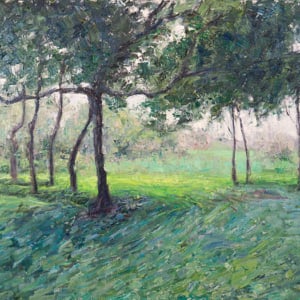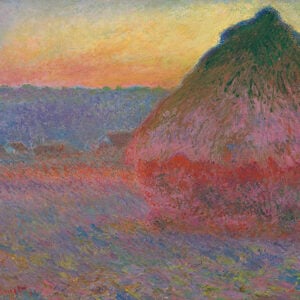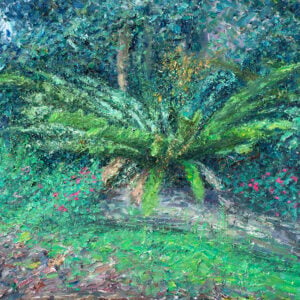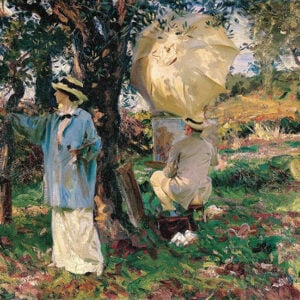In this post, I take a closer look at the remarkably intricate Ophelia by British artist and founding member of the Pre-Raphaelites, Sir John Everett Millais. I cover:
- Key Facts, Ideas, and Subject
- Intricate Detail
- Color and Light
- Composition
- Key Takeaways
- Want to Learn More?
- Thanks for Reading!

Key Facts, Ideas, and Subject
- The figure in the painting is Ophelia, a character from Shakespeare’s Hamlet, Act IV, Scene VII. She is depicted lying in the stream singing, just before she drowns. Below is an extract from the play which poetically describes her death:
“There is a willow grows aslant a brook,
That shows his hoar leaves in the glassy stream;
There with fantastic garlands did she come
Of crow-flowers, nettles, daisies, and long purples
That liberal shepherds give a grosser name,
But our cold maids do dead men’s fingers call them:
There, on the pendent boughs her coronet weeds
Clambering to hang, an envious sliver broke;
When down her weedy trophies and herself
Fell in the weeping brook. Her clothes spread wide;
And, mermaid-like, awhile they bore her up:
Which time she chanted snatches of old tunes;
As one incapable of her own distress,
Or like a creature native and indued
Unto that element: but long it could not be
Till that her garments, heavy with their drink,
Pull’d the poor wretch from her melodious lay
To muddy death.”
- In plain words, she climbed a willow tree to gather exotic flowers. The branch broke and she fell into the “weeping brook” (small river). Her garments “spread wide and mermaid-like” kept her afloat at first from the air trapped underneath. But, she was eventually pulled down by her garments, “heavy with their drink… to her muddy death”.
- The painting was first exhibited in 1852 at London’s Royal Academy of Arts. It received a mixed reception, with many critics praising his technique yet questioning the subject matter. One critic wrote in The Times, “there must be something strangely perverse in an imagination which souses Ophelia in a weedy ditch and robs the drowning struggle of that lovelorn maiden of all pathos and beauty”.
- It was painted in two separate stages: first for the landscape and second for Ophelia. Millais and the Pre-Raphaelites placed considerable importance on the landscape, which explains the remarkably intricate detail used for the background area in this painting.
- He started painting the landscape part in July 1851. Instead of painting from the comforts of his studio, he immersed himself in nature and painted on location. But this did not go without its challenges, as he wrote:
“The flies of Surrey are more muscular, and have a still greater propensity for probing human flesh. I am threatened with a notice to appear before a magistrate for trespassing in a field and destroying the hay … and am also in danger of being blown by the wind into the water. Certainly the painting of a picture under such circumstances would be greater punishment to a murderer than hanging.”
- He reportedly painted the landscape for up to 11 hours a day, six days a week, over five months in 1851.
- Due to poor weather conditions, Millais ended up having a small hut created later that year which was “made of four hurdles, like a sentry-box, covered outside with straw”. Fellow Pre-Raphaelite, William Holman Hunt, was impressed by the hut and had a similar one built for himself.
- Ophelia was modeled by Elizabeth Siddal, who was 19 years old at the time. Millais dressed her in a silver embroidered dress which he purchased from an antique shop for four pounds. He wrote to Thomas Combe in March 1852 about the dress, “Today I have purchased a really splendid lady’s ancient dress – all flowered over in silver embroidery – and I am going to paint it for “Ophelia”. You may imagine it is something rather good when I tell you it cost me, old and dirty as it is, four pounds”.
- Below is a self-portrait by Siddal completed after she modeled as Ophelia:

- Millais had Siddal lay in a bathtub filled with water at his studio in London as he completed the second part of the painting over four months. Below is one of his studies of her face:

- Millais originally included a small water rat in the painting, but it was met with confusion: “Hunt’s uncle and aunt came, both of whom understood most gratifyingly every object except my water rat. The male relation, when invited to guess at it, eagerly pronounced it to be a hare. Perceiving by our smiles that he had made a mistake, a rabbit was then hazarded. After which I have a faint recollection of a dog or a cat being mentioned.” Millais ended up painting over the water rat.
- The painting influenced many artists, such as Salvador Dalí, who wrote in 1936, “How could Salvador Dalí fail to be dazzled by the flagrant surrealism of English Pre-Raphaelitism? The Pre-Raphaelite painters bring us radiant women who are, at the same time, the most desirable and most frightening that exist.” He also created his own rendition of Ophelia, shown here.
- The painting is currently held at Tate Britain for those who wish to see the intricate detail in person.
Intricate Detail
The first thing which comes to mind when I see this painting is the remarkably intricate detail. The whole painting is carefully rendered, even the trees, flowers, and plants in the background.
Below are some close-ups to give you a better idea of the virtuosity of this work. In the first image of Ophelia, notice the subtle white outline surrounding her hand, indicating the presence of water. Small touches like this can go a long way in depicting realism.

In the leaves, notice how they are carefully rendered in light, but get gradually more vague as they recede into shadow. This creates a strong sense of depth.

The area below is particularly sophisticated, with a branch and leaves shooting out into the sunlight, creating an interesting contrast between light and shadow; or delicate and vague.

The plants below would have been challenging to paint, with the awkward shapes and complex shadow arrangements.

Color and Light
The painting features rich colors of nature against the soft, skin tones of Ophelia. The saturated greens give a feel of the luscious, unkempt nature.
In terms of color temperature, the lights appear slightly warm compared to the darks. This is particularly evident in the greens: notice how the greens in shadow are much closer to blue than the greens in light.
Throughout the dense landscape are small bursts of light and color to depict the exotic flowers. As mentioned earlier in the post, Ophelia was collecting these exotic flowers before she fell into the stream.
The colors used for Ophelia are soft and weak. She appears relatively fragile as she lay in the stream, before her “muddy death”. Light colors are used for the subject’s face and hands, drawing your attention towards this area. You can see how much lighter the subject’s face is compared to the surrounding landscape in the grayscale image below:

Composition
The composition is rather simple if you look past all the intricate detail. It boils down to Ophelia laying in the river, surrounded by nature.
Ophelia’s face is partially framed by nature, with the top of the frame being the brown tree trunk and branches, the left of the frame being the plants shooting up from the stream, and the bottom of the frame being the green edge of the shore.
In the photo below, I have segmented the painting into thirds both horizontally and vertically. Notice how Ophelia is positioned almost directly along that lower horizontal line and how her torso is positioned around the bottom-left intersection. These are considered to be aesthetically pleasing areas in a painting.

Finally, you may have noticed the unusual shape of the painting, with the top corners being curved. Though I was unable to find any information on why Millais opted for this shape.
Key Takeaways
Here are some of the key takeaways from this painting:
- Intricate paintings like this are not created overnight; they take weeks, months, or sometimes even years to create.
- Traditionally in portrait painting, the background is pushed back and simplified. But there are no rules against painting the background with just as much detail as the main figure like Millais did in Ophelia. Just make sure there is something to differentiate the figure from the background. In this case, Millais used contrast in value: the figure’s face and hands are much lighter than the surrounding nature.
- Painting from life allows you to see all the subtle nuances which can get lost in a photo. The remarkable intricacy of Ophelia suggests it was painted in a controlled studio environment, but Millais preferred to paint on location.
- If you segment the composition into thirds both ways, the intersecting lines are considered to be aesthetically pleasing areas to position your focal points.
Want to Learn More?
You might be interested in my Painting Academy course. I’ll walk you through the time-tested fundamentals of painting. It’s perfect for absolute beginner to intermediate painters.
Thanks for Reading!
I appreciate you taking the time to read this post and I hope you found it helpful. Feel free to share it with friends.
Happy painting!
Dan Scott

Draw Paint Academy







I have seen this painting in the Tate Gallery ..Absolutely stunning ..
I love this period of painters … You may be interested to look at Frederick
Leighton …His house in Kensington, London UK is utterly splendid complete
With his studio ..It is a work of art and design ….. worth a visit .. I love his
paintings too!
Thanks for sharing all you observations and tips ..helps me enormously
Best Shirley
Thank you for this article Dan and your insights into this wonderfully evocative painting
I do agree… Millais painting is stunning so well put together, so romantic with a detail you recall in your minds eye. I remember seeing at the Tate years ago. I must visit it again…
Some years ago I saw an exhibition of Millais at the Tate in London, it left me with a feeling I had seen something very special,this gets reminded by the book of his works purchased at that visit. Your analysis makes it even more special, thank you Hazel
Beautiful! Thank You for sharing your knowledge.
Amazing how patient he was in the effort to create such a beautiful work of art. I get frustrated with trying to create a painting in 1 to 2 days.
This is a amazing picture. I find that I try to paint in detail too. This is a really reminds that time is needed for beautiful paintings. I get frustrated when it takes so long to paint one part of my picture just right. But then when I finish I am very proud on what I have learned.
Hi Dan
Your comments and analysis of the painting was very interesting. I’m not sure I would ever have the patience to paint a picture that takes that long !!!
I found the segmenting of the painting helpful. Always grateful for your insight as a new painter.
Thank you for this article and especially the close-up shots. I don’t have words for such genius.
Dan I must thank you for sharing all your thoughts and knowledge with us, I have always loved this painting but now look at it in a new light
How I interesting this was! It makes me realize my shortcomings.
Thank you!
Thanks for your very enlightening analysis of the wonderful paintings.
Don’t know how I found your web site but glad I did !
Enlightening on so many levels. Love the painting. Thank you for sharing your knowledge.
Hi Dan
I was inspired by Wm. Blake’s man on a knee. I would like to copy it and put it over my bed. Sleep is heavenly is as the assignments you share. Thank you!
What a beautiful painting.!
Your analysis is extremely interesting to me.
The close-up photographs make the details shine. Thank you for your detailed description.
I do hope I will have the opportunity to see this painting someday in a gallery.
I benefit so much from your articles.
Thank you for this, Dan
Thank you for sharing, very interesting.
That you give us the benefit of your eye and experience restores faith in the world of art.
Thank you. I enjoyed this and look forward to more posts from you.
I value your analysis of this painting. It serves as another lesson in the appreciation of great paintings as well as introducing me to yet, another great painter. Thanks for sharing. I look forward to each of
your posts.
Thanks, Dan! I can appreciate the artist’s work, the Inspiration, perspiration and perseverance and skillful rendering of this morbid painting a lot more now.
In 1976 I did an extensive college presentation on the Pre-Raphaelite Brotherhood. My professor asked to keep all my work. It was a labor of love. Thank you for sharing one of my favs and information I did not know.
Dan,
As usual your explanations are insightful, clear and helpful.
I would be interested to know your perspective on the strategy or techniques Millais would have used to paint outdoors for months, and long daily durations. Cloudy days vs sunny days; shadows, textures and contrasts that change hourly and daily with the movement of sunlight and its shadows; the varying lights of changing seasons; no photography to capture “moments”.
Where do you surmise Millais’ focus was?
Thanks and Cheers,
David
Thank you for sharing this remarkable and beautiful painting. And yes!!! I learn something new from your newsletters ever week. John Mallais was an amazing man and painter, someone
new on my list to research.
Hi David
Great question. There was not much information on this so I can only speculate. I assume what he may have done is pick a direction with the painting then wait for certain times when the environment matched his vision. Or, he worked from what was in his head and used the surroundings mainly for inspiration. Whatever the case, it is a remarkable feat of craftsmanship! Thanks, Dan
Nice, Dan. I enjoyed reading this. Funny…it slowed me down to a crawl.
when reading I was completely emerged and seemed to be on the banks with mosquitos flies and the rough environment of our ever changing weather conditions thank you
What inspiring and valuable observations. Thank you so much!
These breakdowns of artist’s work is invaluable to someone like me. I know it is highly unlikely I would ever come close to this skill shown here but each point is a reminder of what to aim for in my own art. Thank you again.
I have always loved this painting, and do appreciate your showing it here, along with the Shekespearean lines! However, I do wish that you could properly use the corect word “lying” instead of the incorrect “laying” in your first sentence!
Thanks for giving information about Ophelia painting.
Fabulous story to accompany the painting and to better understand the process of a painter.
Amazing picture! Thank you for your effort
II am wondering what the actual dimensions are of this stunning work.
Hi Colleen. It is very large. 76 cm x 1.12 m. Thanks! Dan
Perhaps the round corners at the top of the canvas are symbolic of death and the painting is a tombstone.
Fascinating detail in the painting and what you have published. I believe Elizabeth Siddal suffered as a result of having to lie in a bath of water which got cold. But she survived and Millais’s painting is a masterpiece.
That was truly very interesting. I had never heard of John Everett Millais, or this painting, Ophelia. Amazing detail throughout the painting. Thank u for sharing this with us. Very informative.
I’m not an art major, but here’s my theory on why the painting is shaped as it is. Millais was part of the Pre-Raphaelite Brotherhood, a group of artists whose style emulated late medieval and early Renaissance art.
During that time, arched painting frame designs were used to harmonize with architectural elements including doors and windows. In cathedrals, frescos and murals were painted on the arched entrances and apses.
My final thought is that Millais used this shape as a window or gateway to gaze upon the scene of Ophelia in her moment of death.
Thank you. I’ve been looking for an answer to this question. A few of his paintings have this curved top.